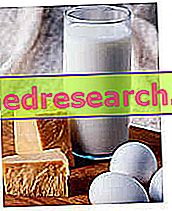What are
The phycocyanins (blue in color), together with the phycoerythrin (red), constitute the phycobilines, or photosynthetic pigments responsible for the absorption of light, typical of cyanobacteria (or blue algae). These photoautotrophic organisms (capable of producing glucose through the absorption of solar rays) are among the oldest forms of life on the planet, for which they have contributed to changing the aquatic and subaerial atmosphere by releasing oxygen.
Structure and Functions
The phycocyanins have a linear molecular structure, analogous to that of an open porphyrinic ring, therefore very similar to that of bilirubin and bile pigments (from which the term ficobiline derives).

As well as cyanophycins, chlorophyll, carotenes, tocopherols, ascorbic acid, zinc, selenium, phenolic compounds, etc., phycocyanins are powerful food antioxidants, highly concentrated in some Klamath algae-based supplements and / or Spirulina, or some edible algae.
It seems that the beneficial-antioxidant efficacy of phycocyanins is positively reflected both in the protection against neoplasia and in the increase in lymphocyte production.
In the food sector, phycocyanins are used as a natural colorant, in ice cream, chewing gum, fermented milks, desserts and bleaching for desserts.
Supplements and health
The phycocyanins interrupt the pro-oxidative action of the peroxides, prevent hepatic lipo-peroxidation (hepato-protective action) and are anti-inflammatory; it has been estimated that phycocyanins possess an antioxidant efficacy that is 40 times higher than that of ascorbic acid (vit. C) and tocopherols (vit. E).
In the experimental field, the action of phycocyanins has been tested in different situations, and more precisely: against acetic acid colitis in rats, against inflammation (always on rats, obtained by: injections of arachidonic acid, injections of carrageenan, cotton pellet plant, acetic acid colitis) and against auricular inflammation in guinea pigs.
Intake doses
The dosages of phycocyanins used in these studies (conducted on rats) amounted to 50-200 mg per kg of body weight, in a proportion of 3.5 / 14 grams in a 70 kg man; considering an average content of about 100-300 mg of phycocyanins per gram of dry klamath / spirulina extract, these are doses that are difficult to reach through normal integration, which occurs at lower doses also for safety reasons (see risk related to microcystins ), typically 2/3 grams for the klamath and 8/12 grams for the spirulina.
Furthermore, it seems that phycocyanins play a very important role in the prevention of some cancers; these neoplasms, related to inflammation, and therefore to the enzymatic expression of COX-2 ( cyclooxygenase 2 or prostaglandin endoperoxide synthase 2 ), appear to be sensitive to treatment with phycocyanins; in a study on guinea pigs, phycocyanins have also been shown to be more effective than the Celticoxib ® and Rofecoxib ® antioxidic drugs. NB .
The cells that produce COX-2 are, unlike the COX-1, characterizing ONLY some tissues (for example, the breast), see in-depth study.
Bibliography:
- Biology, the path of science - Script editions - pag. 121
- Elements of microbiology - GJ Tortota, BR Funke, CL Case - Pearson Benjamin Cummings - pag. 300
- Botanica - Giunti - pag. 36
- Natural food supplements - C. Vasey - URRA - pag. 84
- Practical manual of phytotherapy. Volume 2 - E. Lazzarini, AR Lonardoni - Edizioni Mediterranee - pag. 32
- Antioxidant and anti-inflammatory properties of C phycocyanin from blue green algae - Romay C. et al., - Inflamm Res - 1998 Jan; 47 (1): 36-41
- The phycocyanins, a powerful natural molecule of Klamath algae - Dr. Stefano Scoglio Ph. D. - 2002.



